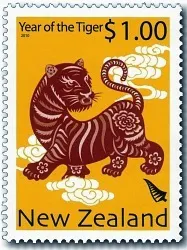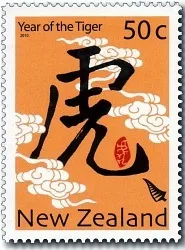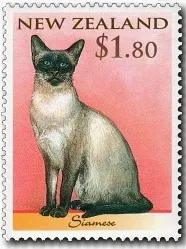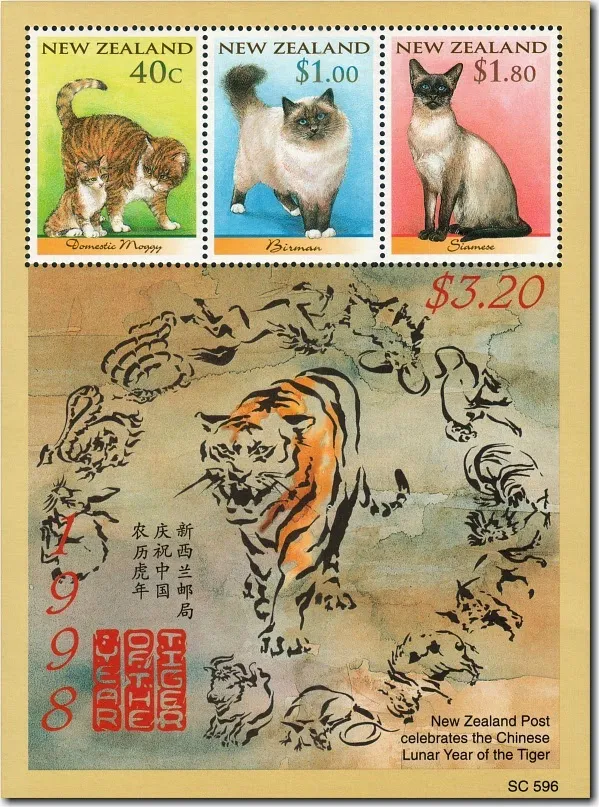 After doing my last Chinese New Year post they suggested I should do another two. At the moment there are only two signs left where NZ Post has released two issues. All the others have been done already in this blog. Go see the links in our Chinese New Year Collection.
After doing my last Chinese New Year post they suggested I should do another two. At the moment there are only two signs left where NZ Post has released two issues. All the others have been done already in this blog. Go see the links in our Chinese New Year Collection.Chinese people have been part of New Zealand’s cultural make-up since the 1860s, when the Dunedin Chamber of Commerce sought workers for the Otago gold mines. From a population of just over 1,200 in 1867, the Chinese/ Taiwanese Chinese population had grown to more than 145,000 – a vital part of a multicultural society. Today (2015) that number is much larger and you will find Chinese, or other Asians in all sectors of New Zealand society.

Chinese New Year festivals have rapidly become a highlight of New Zealand’s entertainment calendar. They include colourful street parades, a bustling Asian markets and local or international cultural performances of various kinds. We usually go to the lantern festival held in Albert Park of downtown Auckland. As well as the displays and lights, there are the dancing displays and stalls. Oh not forgetting the food!
People born in the Year of the Tiger (1914, 1926, 1938, 1950, 1962, 1974, 1986 and 1998) are generally well liked because of their charismatic personalities. Always at their happiest when climbing the ladder of success, they are quick learners and like their sign, often prefer to hunt (work) alone. Famous ‘Tigers’ include Agatha Christie, Marilyn Monroe, Queen Elizabeth II and Tom Cruise.
2010 The Year of the Tiger.
The Stamps.
Like in 2009 the first value 50c showed the Chinese character for the current year, in this case the Tiger, while the second value $1.00 showed a paper cut-out, also of a tiger. The third value, the $1.80 stamp, is a painting of a tiger and is said to show Multicultural New Zealand. This is an important subject, well worth including in a set like this but I must say I am struggling to see it in this stamp design. Of course the final value $2.30 shows the link to New Zealand with the Beehive, a Government building from Wellington. Again all four values featured a cloud background.
That was how Allan described these four stamps on his Chinese New Year page. Notice what he says about the third stamp? Well see my comments on this same stamp below.
50c The Tiger - Pictogram. $1.00 The Tiger - Paper Cut-out.
I must say I really like these more modern Chinese New Year stamps. They are bright, colourful designs that carry a lot of symbolic meaning. Take that first stamp above; the pictogram, the letter of sign of the Tiger you might say, fills most of the stamp showing every tiny stoke in writing the character.
Then the paper cut-out on the $1.00 stamp. I like paper cut-outs, used to make them back in Japan. I had not made one for a very long time since I've tended to leave my traditional Japanese culture and adopt my New Zealand culture. The other day my cousins and I made paper cut-out for Christmas decorations. They look great, hanging in various places around the house.
$1.80 The Tiger. $2.30 New Zealand Icon.
The third stamp, the $1.80, shows Multicultural New Zealand. It appears above that Allan missed it completely. Look closely at the tiger's face. One cheek has a Chinese design while the other clearly shows a fern design. Two cultures blended into one design.
The final stamp shows the link to New Zealand with the Beehive, a Government building from Wellington. In my opinion this is a good looking building but certainly does not look like a bee-hive to me. We have bee-hives on he farm here and they are square boxes but it seems the traditional bee hives from Europe were more that shape.
The miniature sheet shows all four stamps against a colourful background symbolic of Chinese New Year.
1998 The Year of the Tiger.
In 1998 New Zealand again issued a miniature sheet to celebrate the Chinese Lunar New Year of the Year of the Tiger. The three stamps across the top of this sheet came from a set called Cat / Favourite Felines. The release of the ‘Favourite Felines’ issue was timed to coincide with 1998 as the Year of the Tiger. This issue was the second in New Zealand Post’s lunar calendar series, which commenced with the Year of the Ox in 1997. Each sheet of stamps featured a lunar calendar tiger figure in a central gutter strip.
Of these six stamps, only the cat depicted on the 40c value looked anything like a tiger. Again no mention of the Chinese New Year was made on the stamps themselves it is hard to link this set to closely to the Chinese New Year celebrations.
Of these six stamps, only the cat depicted on the 40c value looked anything like a tiger. Again no mention of the Chinese New Year was made on the stamps themselves it is hard to link this set to closely to the Chinese New Year celebrations.
Domestic Moggy - 40c. Burmese - 80c.
Domestic Moggy - 40c
The tabby is the original Egyptian cat from which all other breeds have evolved. Domestic moggies far outnumber the pedigree breeds. They are the very essence of the pure cat.
The tabby is the original Egyptian cat from which all other breeds have evolved. Domestic moggies far outnumber the pedigree breeds. They are the very essence of the pure cat.
Burmese - 80c
Often referred to as the clowns of the cat world, Burmese are extroverted and charming in character. They are highly prized for their sleek, muscular physique and for their bewitching, golden eyes.
Often referred to as the clowns of the cat world, Burmese are extroverted and charming in character. They are highly prized for their sleek, muscular physique and for their bewitching, golden eyes.
Birman - $1.00. British Blue - $1.20.
Birman - $1.00
This long-haired cat possesses a gentle and dignified air, and the heart-melting gaze of deep blue eyes. Today, the Birman continues to increase in popularity, as more and more cat lovers find a place in their lives for this faithful and devoted companion.
This long-haired cat possesses a gentle and dignified air, and the heart-melting gaze of deep blue eyes. Today, the Birman continues to increase in popularity, as more and more cat lovers find a place in their lives for this faithful and devoted companion.
British Blue - $1.20
Stocky, strong, gentle and patient, British Blues charm all who come into contact with them. Other features making British Blues very special are their crisp, dense coat and spectacular round, golden eyes.
Stocky, strong, gentle and patient, British Blues charm all who come into contact with them. Other features making British Blues very special are their crisp, dense coat and spectacular round, golden eyes.
Persian - $1.50. Siamese - $1.80.
Persian - $1.50
Brought back to Europe in the early seventeenth century, from the Chorazen Province of what is now Iran, Persians are aristocratic, good natured and easy-going. They are doted on by their owners, which may explain why they are totally incapable of looking after themselves!
Brought back to Europe in the early seventeenth century, from the Chorazen Province of what is now Iran, Persians are aristocratic, good natured and easy-going. They are doted on by their owners, which may explain why they are totally incapable of looking after themselves!
Siamese - $1.80
Probably the most easily recognised of the pedigree cats, the Siamese has a sleek body, a steely blue gaze and a voice that is both unique and penetrating. Though they are fiercely loyal and adore children, no cat lover can ever own a Siamese. Rather, the Siamese owns you!
Probably the most easily recognised of the pedigree cats, the Siamese has a sleek body, a steely blue gaze and a voice that is both unique and penetrating. Though they are fiercely loyal and adore children, no cat lover can ever own a Siamese. Rather, the Siamese owns you!
The Hidden Tigers.
The stamps came with vertical gutter strip of 10 tiger figures through the middle of each sheet. I have called these the hidden tigers because it is only if you were fortunate enough to see a whole sheet that you would have seen them. In most cases they would have been thrown away by the Post Office staff as stamps off the sheet were purchased. Below can be seen a $1.00 stamp along with a section of the non postal gutter strip with one of those hidden tigers.
Finally we have the First Day Cover, with a cat and kitten. Check out that neat postmark in the shape of a cat's paw mark.
The Year of the Tiger Miniature Sheet and its First Day Cover.
Technical information 2010.
Date of Issue:
| 6 January 2010 |
|---|---|
Number of stamps:
| Four gummed stamps |
Denominations:
| 50c, $1.00, $1.80, $2.30 |
Designed by:
| Bananaworks, Auckland, New Zealand |
Printer and process:
| Southern Colour Print Ltd by offset lithography |
Number of colours:
| Four process colours |
Stamp size and format:
| 30mm x 40mm (vertical) |
Miniature sheet:
| 150mm x 90mm (horizontal) |
Paper type:
| Tullis Russell 104gsm red phosphor gummed stamp paper. |
Number of stamps per sheet:
| 25 stamps |
Perforation gauge:
| Stamp sheets: 14; Miniature sheets: 13.33 x 13.60 |
Technical information 1998.
Date of Issue:
| 11 February 1998 |
|---|---|
Designers:
| Stamps: Julie Greig, Wellington, New Zealand; Miniature Sheet Designer: Lindy Fisher, Auckland, New Zealand |
Printer:
| Southern Colour Print, New Zealand |
Stamp Size:
| 30mm x 40mm; Miniature Sheet Size: 100 x 135mm |
Sheet Size:
| 100 stamps per sheet |
Process:
| Lithography |
Perforation gauge:
| 13.6 |
Paper Type:
| 104 gsm red phosphor coated |
Some of the images and prices in this post were used with permission from the illustrated catalogue of StampsNZ
You can visit their web site and On-line Catalogue at, http://stampsnz.com/
Some information on this post came from the NZ Post Web Site.













We appreciate your engagement with our content. To ensure a respectful and constructive community, please take note of the following:
- No Spam, Please: We do not tolerate spammy or promotional comments. Any such comments will be promptly removed.
- Moderation in Place: All comments are moderated to maintain a positive and inclusive environment. Please be patient, as it may take a little time for your comment to appear.
- Sign In with Google: To comment, please sign in using your Google account. This helps us maintain the integrity of our community and allows for better interaction.